Allocate Unit Size For FAT32 Choice
Summary
What's best allocation unit size for fat32 file system? This article shows you how to set cluster size for fat32 usb drive, sd card or hard disk fat32 partition with the best size.
Quick Navi
1. What cluster size is best for FAT32 File System
FAT32 uses 32-bit space to represent the situation of each sector (Sector) profile. The maximum size of a single partition that can be used with FAT32 is 2TB (2048GB).
The following is a summary of the partition and cluster sizes.
FAT32 Storage Size and Cluster Size in Windows
32MB-127MB - 512bytes
128MB-255MB - 512bytes
256MB-259MB - 512bytes
260MB-511MB - 4KB
512MB-1023MB - 4KB
1024MB-2047MB - 4KB
2G-8GB - 4KB
8GB-16GB - 8KB
16GB-32GB - 16KB
For sd/usb above 32GB, such as 64GB and above, exfat is applied - 64kb
For examples:
- Allocation unit size fat32 8GB ->8k
- Allocation unit size fat32 16GB -> 16k
- Allocation unit size fat32 64GB -> 64k
- Allocation unit size fat32 128GB -> 64k
- Allocation unit size fat32 256GB -> 64k and above
- Allocation unit size fat32 1tb -> 64k and above
2. Allocation unit size for fat32 drive/card over 32GB to 64k
If you have a usb flash drive or hard disk partition or memory card that is over 32GB, 64gb or 128gb for example, it is not possible to set it fat32 in Windows format.
Example: I have a E drive on an SSD, the volume is around 250GB, when I click format it in File Explorer, there is no FAT32 file system option for the E drive but just NTFS in Windows 10.
How to set drive/usb FAT32? -> Free fat32 formatter may help.
IM-Magic Partition Resizer Free is a free fat32 formatter that can help format drive to FAT32 and it also offers allocation unit size selection to 64k as you expected.
Step1: Download the free tool, install it on your computer.
Download IM-Magic Partition Resizer Free Edition
Step2: Right click the drive, and choose 'Format Partition' option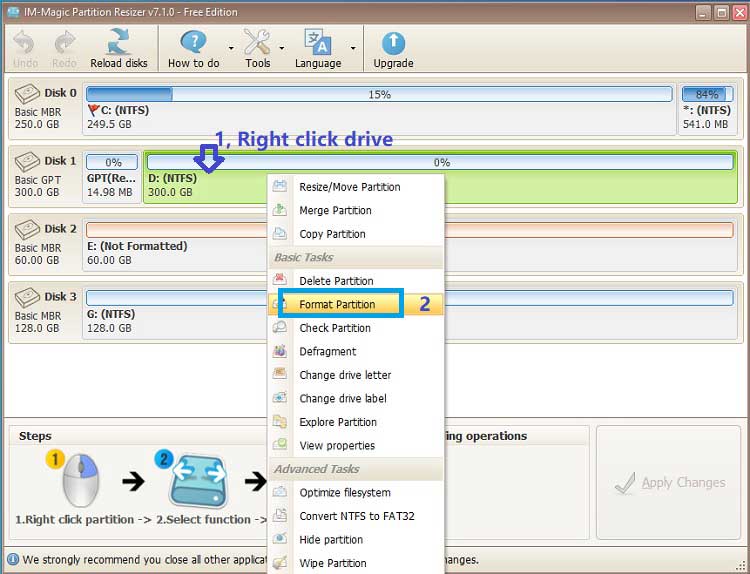
Step3: Set the format option and change the cluster size if you need
This following image shows to format a drive near 537GB to file system FAT32 with allocation unit size 64k with free tool IM-Magic Partition Resizer if you right click the drive in the software, the following image will show up for block size selection with fat32.
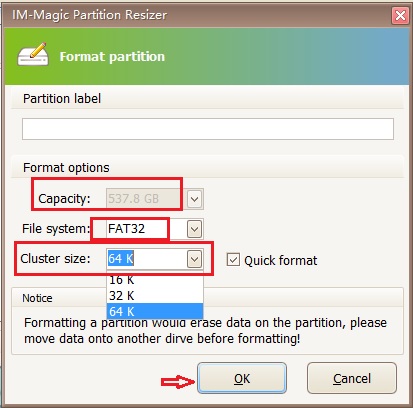
How to check allocation unit size fat32 of a current usb or hard disk?
If you do not know what allocation unit size is your fat32 storage drive, you may do the following.
Method#1 - cmd filesystem
Filesystem is the command line that can be used to check the current allocation unit size for your drive no matter hard disk drive, usb flash drive or sd card.
You may test the current block cluster size with the following cmd
- 1, Open cmd and run it as admin
- 2, Type 'diskpart' and press enter
- 3, Type 'list disk' and press enter
- 4, Type 'select disk *' (You need to replace * with your own disk number and partition number, we typed 'select disk 1' in this case)
- 5, Type 'list partition'
- 6, Type 'select partition *'
- 7, Type 'filesystem'
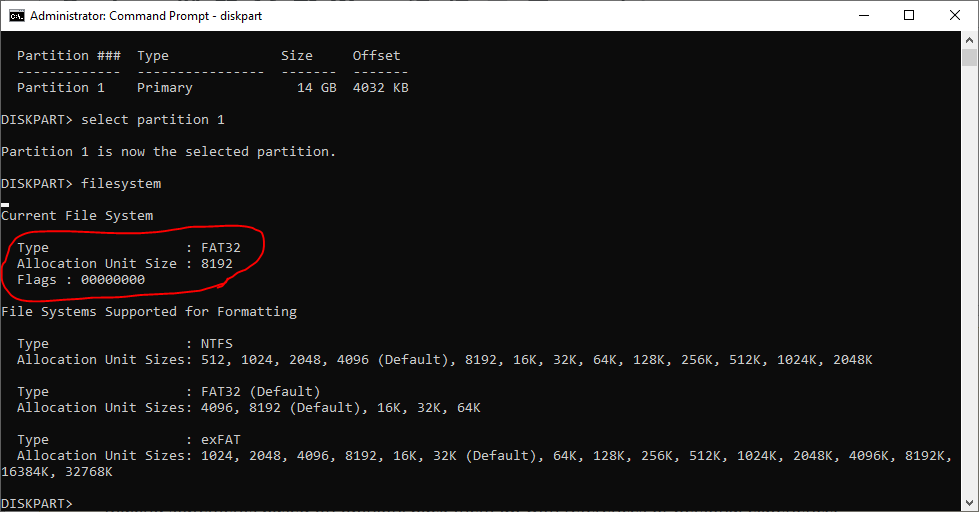
Method#2 - The cluster size of FAT32 is usually 4KB, you can create a new txt document inside your USB drive, then write a character in it, and then right click the file to check its properties. The size of the occupied space is the size of a cluster.
Method#3 - cmd to check local fat32 drive on a pc
fsutil fsinfo ntfsinfo [your drive]
This above cmd is the terms to know the current allocation unit size of your local drive (external drives exempted)
Method#4 - powershell
Run this powershell command.
Get-Volume | Format-List AllocationUnitSize, FileSystemLabel
Question: What is the appropriate size of a FAT32 partition cluster?
4K is best for fat32 usb/sd card less than 8GB or you may leave it default allocation unit size when formatting by Windows or other third party format utilities.
Question: Allocation cluster size for fat32 over 32GB
64K is best as the cluster size when formatting usb/sd/partition to exfat/ntfs file system
Also read: How to set usb/sd from 4k to 64k
Note: FAT32 partitions can only support up to 32GB partitions and up to 4GB for a single file. (It's not suitable if you want to save game files and movide files onto the fat32 partition due to this file size limit.)
FAT32 was developed from FAT and FAT16. Its advantages are good stability and compatibility, full compatibility with Win9X and previous versions, and easy maintenance. The disadvantage is poor security.
FAT32 file system consists of DBR and reserved sectors, FAT1, FAT2 and data area.
1. DBR and reserved sectors: DBR means DOS boot record, also called operating system boot record, and there are often some reserved sectors after DBR.
2. FAT1: FAT refers to File Allocation Table, FAT32 usually has two fat copies, FAT1 is the first and main fat one.
3.FAT2: FAT2 is the second file allocation table of FAT32, which is the backup of FAT1.
4. DATA: DATA or DATA section is the main part of the FAT32 file system, which contains the directory area.
3. Allocation unit size for fat32 changed to ntfs
Allocation unit size selection is available when you change file system to fat32 to ntfs. You may get it done by the following ways.
#1, Delete sd/usb that has fat32 file system under disk management, and create new volume for it under disk management with new file system NTFS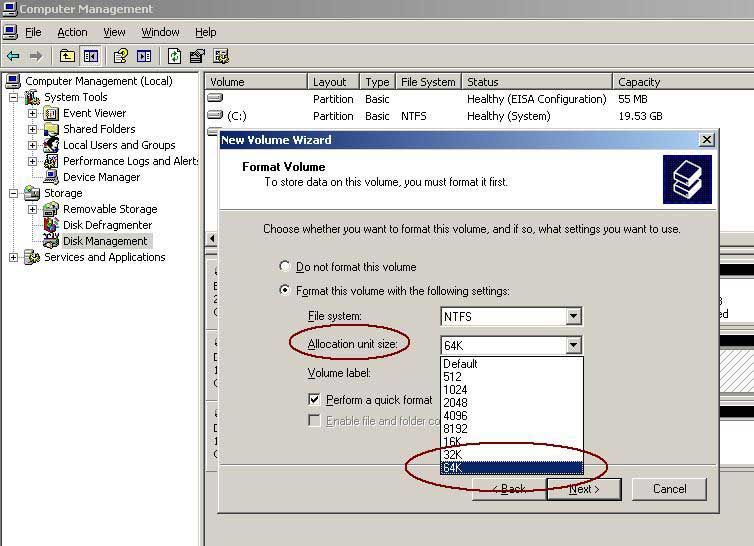
#2, Format fat32 usb/sd or hard drive to ntfs with format methods
- 2.1, Format fat32 to ntfs with right click format option in Windows file explorer (You may open THIS PC on your desktop, and then right click your fat32 usb/sd/disk partition, go to Format, and a window with allocation unit size column will appear in this step)
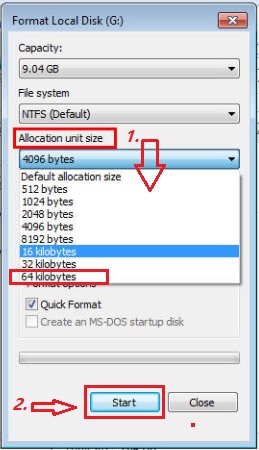
- 2.2, Format fat32 drive with format tools such as IM-Magic Partition Resizer Free which is totally free of charge and you can use its right click format partition function to change the cluster size in the next window.
- 2.3, Format fat32 drive to ntfs in Disk Management when you right click the fat32 drive, and go to "Format" option, then the cluster size change column will show up for selection.
FAQs
Q: How to set allocation unit size to 64k for drives over 32gb that has fat32 file system?
A: Formatting with thrid party utlities such as Partition Reszier Free which allows selection drive over 32GB to allocation cluster size 16k, 32k, and 64k. (It's totally free of charge)
Details are on this page: how to change unit size from 4k to 64k
More Related Articles You May Like
- Change disk allocation unit size without formatting
- Does cluster size affect disk speed
- Is allocation unit size bigger better
- Allocation unit size for gaming
- Allocation unit size for usb flash drive
- Allocation unit size for fat32
- Allocation unit size for ntfs when formatting
- Allocation unit size for exfat
- Allocation unit size for 128gb sd card
- What is Allocation unit size
Related Product
- IM-Magic Partition Resizer Server - Partition space redistributing software that works for Windows Server 2003-2025.

